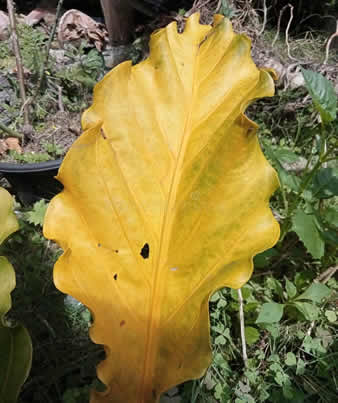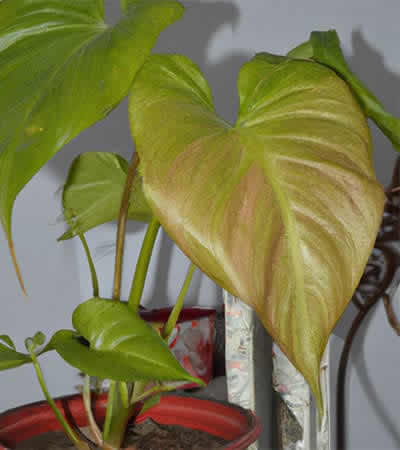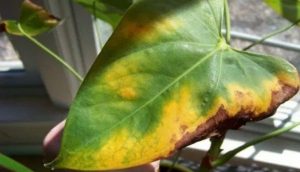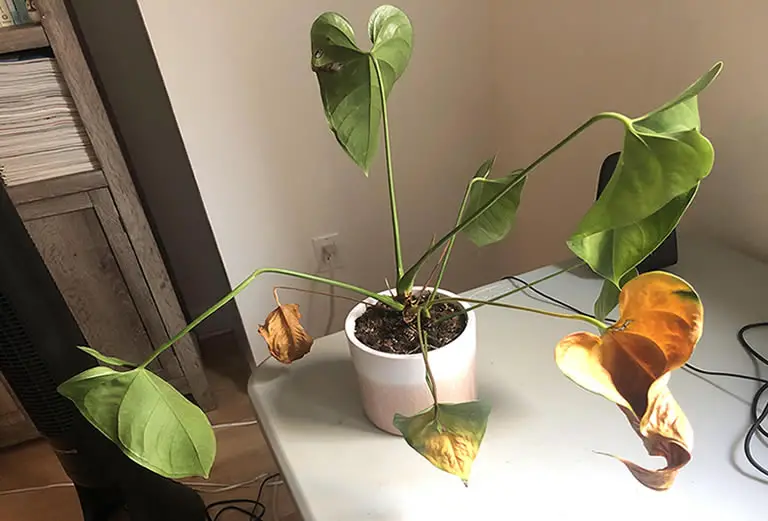Anthuriums are known for their striking foliage and vibrant blooms, so it can be disheartening to see those glossy green leaves fading to yellow. But don’t worry—yellowing leaves are common and usually fixable. Understanding what’s causing the change is the first step toward bringing your plant back to full health.
Yellow leaves can signal anything from watering issues and low humidity to poor soil or lighting problems.
The good news? Once you identify the cause, it’s usually easy to make the right adjustments.
Let’s walk through each potential reason your Anthurium’s leaves are turning yellow and what you can do to help your plant recover.
Table of Contents
- 1. Overwatering Is the Most Common Cause of Yellow Leaves
- 2. Low Humidity Can Lead to Yellowing and Browning
- 3. Nutrient Deficiency from Poor or Excessive Fertilization
- 4. Poor Soil Quality Affects Root Health and Leaf Color
- 5. Too Much Sunlight Can Scorch Leaves and Turn Them Yellow
- 6. Temperature Fluctuations and Cold Stress
- 7. Seasonal Shifts Can Affect Water Needs and Health
- 8. Natural Leaf Aging—Sometimes It’s Just Part of the Cycle
- Anthurium Care Summary: How to Keep Your Plant Healthy
- Extra Tips: Repotting and Flower Color Changes
- Final Thoughts
1. Overwatering Is the Most Common Cause of Yellow Leaves
Anthuriums like their soil moist—but not wet. If the roots sit in soggy soil for too long, they can’t breathe properly, which leads to stress and root rot.
That stress often shows up first in the form of yellowing or browning leaves, fading flowers, or even leaf loss.

Unlike some houseplants, Anthuriums don’t want their soil to completely dry out either.
The key is balance: the top inch or two of soil should dry out between waterings, but the rest should stay lightly moist.
Tips to avoid overwatering:
-
Use well-draining soil and pots with drainage holes
-
Water thoroughly, then allow excess water to drain completely
-
Check moisture with your finger before watering again
Mastering your plant’s watering routine takes time, but it’s the most important skill you can build for Anthurium care.
2. Low Humidity Can Lead to Yellowing and Browning
Since Anthuriums are native to humid tropical regions, they thrive in environments where the air moisture is high.
Indoor humidity, especially during winter or in air-conditioned rooms, often falls well below what these plants need.
If your Anthurium is getting proper water but still has yellowing leaves or brown edges, low humidity might be the problem.
Easy ways to boost humidity:
-
Place the plant on a pebble tray with water
-
Group it with other humidity-loving plants
-
Use a small room humidifier
-
Relocate to a naturally humid space like a bathroom
Aim for at least 60% humidity to keep those velvety leaves vibrant and healthy.
3. Nutrient Deficiency from Poor or Excessive Fertilization
Anthuriums aren’t heavy feeders, but they do need a little help during the growing season.
If you’ve never fertilized your plant or used only plain water for months, it could be lacking essential nutrients.

On the flip side, too much fertilizer can burn the roots and make it harder for the plant to absorb what it needs, also leading to yellowing.
How to fertilize correctly:
-
Use a balanced, water-soluble fertilizer at ¼ strength
-
Apply once per month during spring and summer
-
Skip feeding in fall and winter
-
If you’ve over-fertilized, flush the soil thoroughly and pause feeding for a few months
I find that this liquid feed works great with Anthurium.
Less is more when it comes to feeding Anthuriums—just enough to support healthy foliage and flowers.
4. Poor Soil Quality Affects Root Health and Leaf Color
If your Anthurium is planted in dense, soggy, or nutrient-poor soil, it will struggle to grow well.
Compacted soil prevents roots from getting the oxygen they need, and poor drainage makes root rot more likely.
Soil that doesn’t meet the plant’s needs can lead to yellow leaves, slow growth, and fewer flowers.
An ideal mix includes:
-
Equal parts peat moss (or coconut coir), pine bark, and perlite
-
A slightly acidic pH (around 5.5 to 6.5)
-
A loose, airy texture that holds moisture without staying soggy
If your soil feels heavy or stays wet for too long, consider repotting your Anthurium into a fresh mix.
5. Too Much Sunlight Can Scorch Leaves and Turn Them Yellow
Anthuriums are forest-floor dwellers, adapted to dappled light under a canopy.
While they need bright light to grow and bloom, direct sunlight is too intense and often causes the leaves to yellow, crisp, or develop burn spots.
Signs your Anthurium is getting too much sun:
-
Pale yellow leaves near the top or outer edges of the plant
-
Brown, crispy tips or edges
-
Faded or bleached leaf patches
Ideal light conditions:
-
Bright, indirect light
-
North or east-facing windows are great
-
For south-facing rooms, move the plant back several feet or use sheer curtains
If your plant isn’t blooming despite healthy leaves, it may need more light. Balance is key—bright, but never direct.
6. Temperature Fluctuations and Cold Stress
Anthuriums prefer stable temperatures between 70–85°F (21–29°C).
If the temperature drops below 60°F (16°C), or the plant is exposed to drafts or fluctuating conditions, the stress can cause chlorosis—breakdown of chlorophyll—and lead to yellowing leaves.

Keep your plant away from:
-
Drafty windows or doors
-
Cold AC vents or fans
-
Hot radiators and heaters
Try to maintain consistent warmth and avoid sudden changes.
7. Seasonal Shifts Can Affect Water Needs and Health
Yellowing may sometimes align with seasonal changes. In winter, your Anthurium’s growth slows, so its water needs drop dramatically.
Overwatering during this dormant phase can cause issues even if your routine worked perfectly during summer.
Check the soil more often in colder months, but don’t stick to a rigid watering schedule. Let the plant tell you what it needs.
8. Natural Leaf Aging—Sometimes It’s Just Part of the Cycle
Not all yellowing is a sign of trouble. Anthuriums, like all plants, naturally shed older leaves to make room for new growth.
These will usually be the lower leaves, and the change will happen slowly.
If your plant seems otherwise healthy and you only see one or two yellow leaves at a time, this is likely just natural aging.
Simply remove the faded leaves to keep the plant looking tidy.
Anthurium Care Summary: How to Keep Your Plant Healthy
To avoid yellowing leaves in the future, try to keep your Anthurium’s environment as consistent and close to its tropical roots as possible.
Here’s a quick summary of what it needs:
-
Keep temperatures steady between 70–85°F (21–29°C)
-
Use a well-draining mix (equal parts peat, bark, and perlite)
-
Provide bright, indirect light
-
Boost humidity to at least 60%
-
Fertilize once per month during the growing season at ¼ strength
-
Avoid overwatering and allow the top inch of soil to dry between waterings
-
Repot when the soil compacts or becomes waterlogged
Extra Tips: Repotting and Flower Color Changes
Repotting Tips:
-
Water your plant before repotting for easier handling
-
Use a pot just slightly larger than the original
-
Clay pots with drainage holes are ideal
-
Be gentle when untangling roots
Why Are My Anthurium Flowers Fading from Red to Green or Yellow? Changes in flower color often come down to stress.
Common causes include low humidity, excess light, or nutrient imbalances. Stick to consistent care, and your plant should return to producing its signature crimson blooms.
Final Thoughts
It can be alarming to see your Anthurium’s leaves turning yellow, but it’s usually a signal—not a sentence.
With a little observation and the right adjustments, you can restore your plant’s vibrancy and help it thrive for years to come.
If you’re ever unsure where to start, revisit the basics: check the light, test the soil moisture, look for signs of pests, and make sure your plant’s environment matches its tropical origins.
With that foundation in place, your Anthurium will thank you with lush, healthy growth.
You may be interested in the following articles about Anthurium care:
Anthurium Care Guide: How to Keep These Tropical Stunners Thriving
Why Your Anthurium Isn’t Blooming and 7 Ways to Encourage Flowers Again
Brown Leaves on Your Anthurium? Here’s What’s Really Going On
Anthurium Warocqueanum Care Guide

